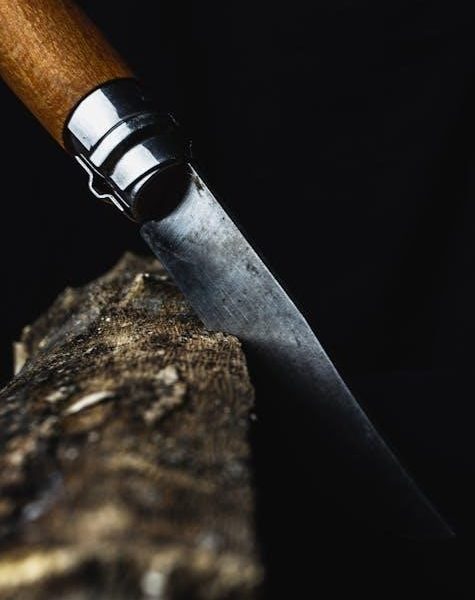
manual key cutting tool
Manual key cutting machines are reliable tools for duplicating keys, offering precision and efficiency. They are essential for locksmiths and professionals needing accurate key reproduction with minimal effort.
Types of Key Cutting Machines
Key cutting machines are categorized into manual, semi-automatic, and automatic types, each offering distinct functionality to suit different needs and levels of precision in key duplication.
2.1 Manual Key Cutting Machines
Manual key cutting machines are simple, cost-effective tools used for duplicating keys. These machines require manual operation to trace and cut keys accurately. They are lightweight, portable, and ideal for small-scale use. Popular models like the Ilco 110V and Xhorse Dolphin XP-007 are known for their versatility, handling various key types, including automotive and residential. They often feature adjustable settings for different key sizes and are preferred by locksmiths for their ease of use and reliability. Maintenance is straightforward, ensuring long-term functionality. These machines remain essential for precise key duplication in various industries.
2.2 Semi-Automatic Key Cutting Machines
Semi-automatic key cutting machines combine manual and automated features, offering faster and more efficient key duplication. They are designed for locksmiths and professionals who need higher productivity without full automation. These machines often include advanced features like electronic calibration sensors and built-in motors for precise cuts. Models such as the Keyline BI884-MINI and Xhorse Dolphin XP-008 are popular choices, capable of handling dimple, laser, and flat keys. They are portable, easy to use, and require minimal setup. Regular maintenance, such as cleaning and lubrication, ensures optimal performance. Semi-automatic machines strike a balance between manual control and automated efficiency, making them versatile tools for various key-cutting needs.
2.3 Automatic Key Cutting Machines
Automatic key cutting machines are high-tech devices designed for advanced key duplication, offering superior speed and accuracy. They are ideal for professional locksmiths and large-scale operations. These machines utilize computerized systems to precisely cut keys, often integrating features like laser guidance and automated alignment tools. The Speed 040 from Silca is a notable example, capable of handling both manual and automatic modes for versatility. Automatic machines minimize human error and maximize efficiency, making them a valuable investment for businesses requiring high-volume key production. They are typically more expensive than manual or semi-automatic models but deliver unparalleled performance and reliability. Regular maintenance ensures their longevity and optimal functionality.

Features of Manual Key Cutting Machines
Manual key cutting machines are known for their portability, precision, and versatility, enabling locksmiths to duplicate keys accurately. They often feature durable designs and easy operation, making them ideal for various locksmithing tasks.
3.1 Portability
Manual key cutting machines are designed for portability, allowing locksmiths to work in various locations. Their compact size and lightweight design make them easy to transport, enhancing on-site efficiency. Many models, like the Xhorse Dolphin XP-007, are battery-powered, eliminating the need for a power source. This feature is particularly useful for locksmiths who operate mobile services or work in remote areas. Portability ensures that professionals can deliver quick and reliable key duplication services wherever they go, making these tools indispensable in the locksmithing industry. Their ease of transport contributes to faster response times for emergency key-cutting needs. Additionally, the ability to carry these machines effortlessly reduces operational constraints, enabling locksmiths to adapt to diverse working environments.
3.2 Precision
Manual key cutting machines are engineered to deliver high precision, ensuring accurate key duplicates. They feature advanced mechanisms to replicate the exact dimensions of the original key, minimizing errors. Models like the Ilco 110V and Xhorse Dolphin XP-007 are renowned for their ability to cut keys with exceptional accuracy. This precision is crucial for locksmiths, as even slight inaccuracies can render a key unusable. The machines’ ability to handle various key types, including automotive and residential keys, further underscores their reliability. By maintaining consistent and precise cuts, these tools are indispensable for professionals requiring dependable key duplication results. Their engineering ensures durability and consistent performance over time.
3.3 Versatility
Manual key cutting machines are highly versatile, capable of cutting a wide range of key types, including flat, laser, dimple, and automotive keys. Models like the Ilco 110V and Xhorse Dolphin XP-007 support multiple key styles, making them adaptable for various locksmithing needs. Their compact designs allow for easy transport, enabling professionals to work on-site or in-shop. Additionally, some machines offer dual power options, functioning with both battery and electric power, enhancing their usability in different environments. This versatility makes manual key cutters indispensable tools for locksmiths, providing flexibility and reliability across diverse applications. Their ability to handle complex key designs ensures they remain essential in the industry.

Popular Manual Key Cutting Tools
Popular manual key cutting tools include the Ilco 110V, Xhorse Dolphin XP-007, and Keyline BI884-MINI, known for their reliability, portability, and ability to handle various key types.
4.1 Ilco 110V Manual Key Cutting Machine
The Ilco 110V Manual Key Cutting Machine is a reliable and efficient tool for duplicating edge-cut keys. It handles automotive, residential, and commercial keys with ease. The machine features a single-phase motor operating at 1350 RPM, ensuring precise cuts. Its compact design, with dimensions of 15.75″ (400 mm) width and 18.1″ (460 mm) depth, makes it suitable for various workspaces. Known for its durability, it is a popular choice among locksmiths seeking a versatile and dependable solution for key duplication. This machine supports quick and accurate key cutting, enhancing productivity for professionals.
4.2 Xhorse Dolphin XP-007
The Xhorse Dolphin XP-007 is a portable and versatile manual key cutting machine designed for precision and convenience. It supports cutting flat, laser, and dimple keys, making it ideal for automotive, bike, and other specialized applications. The machine operates on both battery and power, offering flexibility for on-the-go use. Weighing approximately 15KG, it is lightweight and easy to transport. Equipped with an electronic calibration sensor and a battery power indicator, it ensures accurate and efficient key duplication. Its compact design and robust features make it a favorite among locksmiths and professionals seeking reliable performance in various environments.
4.3 Keyline BI884-MINI
The Keyline BI884-MINI is a compact yet powerful manual key cutting tool designed for locksmiths and professionals. It specializes in key cloning and decryption, making it ideal for working with a variety of key types. This machine is known for its portability and user-friendly interface, allowing for precise and efficient key duplication. The BI884-MINI supports multiple key formats, including dimple and wave keys, ensuring versatility in different applications. Its compact size and robust functionality make it a popular choice for those requiring reliable performance in both workshop and mobile settings; It is a trusted tool in the locksmithing industry due to its durability and accuracy.
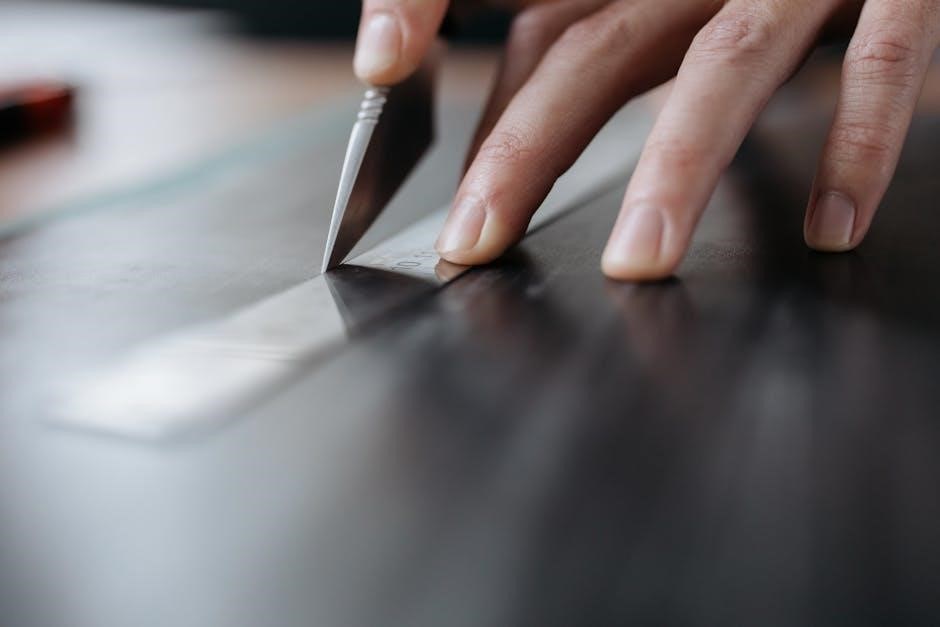
How to Use a Manual Key Cutting Machine
Using a manual key cutting machine involves preparing the machine, aligning the original key, and carefully cutting the duplicate using the cutting wheel. Precision is key for accurate results.
5.1 Preparation
Before cutting, ensure the machine is on a stable surface and plug it in. Wear safety goggles, gloves, and a dust mask. Align the original key securely in the machine’s vice, ensuring it’s flat and properly positioned. Set the cutting depth according to the key type. Select the appropriate cutting wheel for the job. Double-check the key alignment and machine settings to avoid errors. Proper preparation ensures accurate and efficient key duplication, minimizing waste and optimizing results. Once everything is ready, proceed to the cutting process with confidence.
5.2 Cutting Process
Once prepared, start the machine and carefully feed the key into the cutting wheel. Maintain steady, controlled pressure, ensuring the key aligns with the guide. Move the key smoothly across the wheel, following the original key’s pattern. Monitor the cutting process to avoid applying too much pressure, which could damage the key or machine. After cutting, inspect the duplicate key for accuracy. If needed, make minor adjustments and repeat the process. Always follow safety guidelines and clear instructions for precise results. Proper technique ensures high-quality key duplication with minimal effort and maximum efficiency.
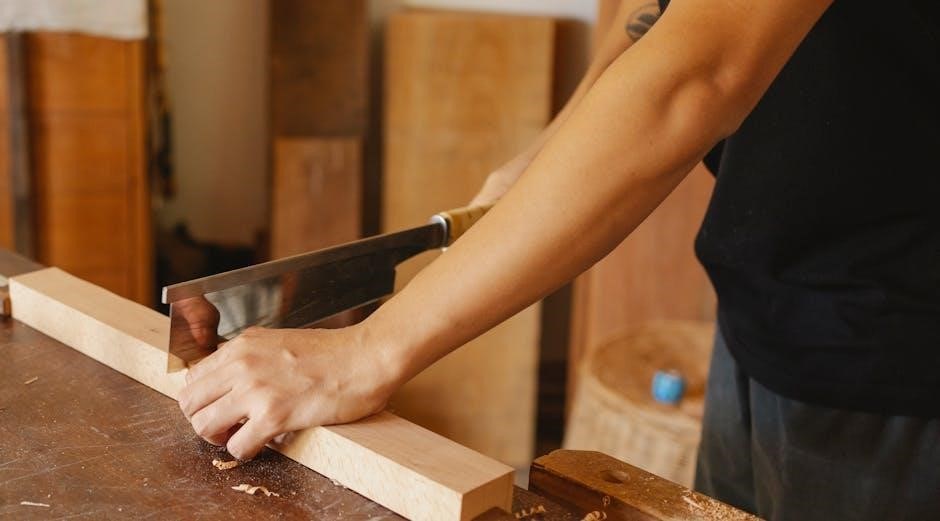
Safety Precautions
Always clear the workspace and avoid loose clothing. Keep children away and ensure proper machine handling. Stay focused and avoid distractions during operation.
6.1 Personal Protective Equipment
Protective gear is essential when using manual key cutting machines to prevent injuries. Always wear safety goggles to shield eyes from metal shavings and debris. A dust mask is recommended to avoid inhaling fine particles released during cutting. Protective gloves safeguard hands from sharp edges and cuts. Additionally, ensure long hair and loose clothing are tied back to avoid accidental entanglement with moving parts. Proper footwear, such as steel-toe shoes, can also provide extra protection in workshop environments. Prioritizing PPE ensures a safer and more controlled key-cutting experience.
6.2 Workspace Setup
A well-organized workspace is crucial for efficient and safe key cutting. Ensure the area is clean and stable, with the machine placed on a flat, sturdy surface. Proper lighting is essential to clearly see the key alignment and cutting process. Use a vice or clamp to secure the machine if needed. Keep tools and accessories, such as cutting wheels and alignment guides, within easy reach. A small container for collecting metal shavings will help maintain a tidy environment. A well-prepared workspace enhances precision, reduces risks, and streamlines the key-cutting process.
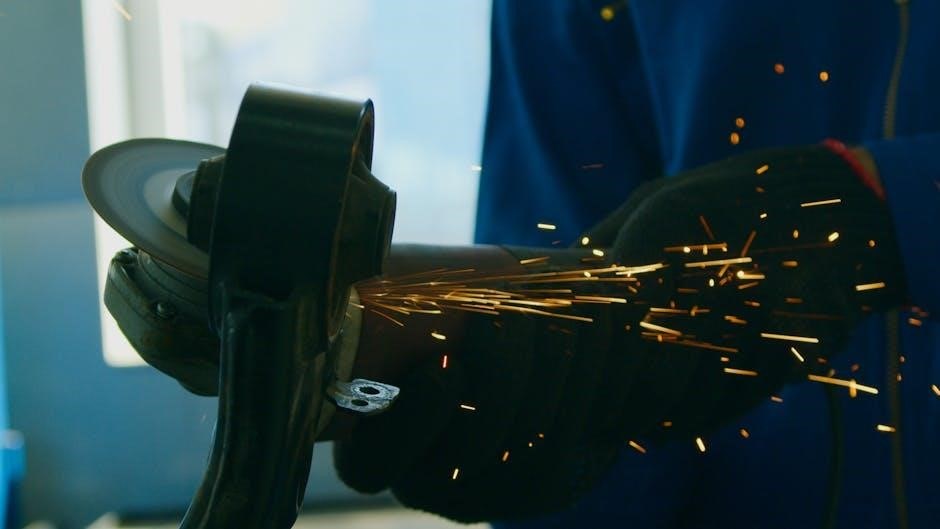
Maintenance and Care
Regular maintenance ensures optimal performance of manual key cutting machines. Clean the machine after use, lubricate moving parts, and check calibration to maintain accuracy and extend lifespan.
7.1 Cleaning
Regular cleaning is essential for maintaining the performance of manual key cutting machines. Use a soft brush or compressed air to remove metal shavings and debris from the cutting area. Dampen a cloth with mild detergent to wipe down surfaces, avoiding harsh chemicals that may damage components. Ensure all moving parts are free from grime to maintain smooth operation. After cleaning, dry the machine thoroughly to prevent rust. Consistent cleaning prevents dust and residue buildup, ensuring accurate key cuts and extending the machine’s lifespan. Always clean the machine after each use for optimal efficiency and durability.
7.2 Lubrication
Proper lubrication is crucial for maintaining the smooth operation of manual key cutting machines. Apply a light oil or silicone-based lubricant to moving parts, such as gears and pivot points, every 1-2 months. Use a clean cloth to wipe off excess lubricant, ensuring no residue attracts dust. Avoid using heavy greases, as they can clog internal mechanisms. Regular lubrication reduces friction, prevents rust, and ensures precise cutting. It also extends the machine’s lifespan by minimizing wear and tear. Always refer to the manufacturer’s guidelines for recommended lubricants and application frequencies to keep your tool in optimal working condition.
7.3 Calibration
Calibration ensures your manual key cutting machine operates accurately. Start by using the provided adjustment tools to align the cutting wheel and key clamp. Adjust the depth settings to match the key type being cut. For precise alignment, use the machine’s built-in calibration guide or electronic sensors, as found in models like the Xhorse Dolphin XP-007. Regular calibration prevents errors in key duplication. After calibration, test the machine by cutting a sample key to ensure accuracy. Always refer to the manufacturer’s manual for specific calibration instructions, as improper settings can lead to inconsistent results and damage the tool. Proper calibration is essential for maintaining the machine’s performance and longevity.
Troubleshooting Common Issues
Common issues with manual key cutting machines include misalignment, dull cutting wheels, and improper calibration. If the machine misaligns keys, check the clamp and adjust it. Dull wheels can be replaced or sharpened. Calibration errors often cause inaccurate cuts; refer to the manual for recalibration steps. Lubricate moving parts if the machine operates sluggishly. For motorized models, ensure power settings are correct. Always clean the machine after use to prevent debris buildup. If issues persist, consult the manufacturer’s troubleshooting guide or contact professional support. Regular maintenance and proper tool storage can help minimize these problems and extend the machine’s lifespan.
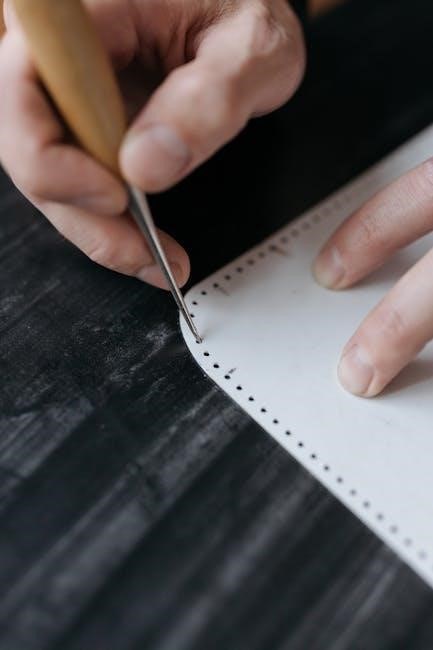
Key Cutting Machine Accessories
Essential accessories for manual key cutting machines include cutting wheels, alignment tools, and lubricants. Cutting wheels ensure precise cuts, while alignment tools maintain key accuracy. Lubricants keep machinery running smoothly, reducing wear. Additional accessories like key clamps and dust collection kits enhance efficiency and cleanliness. These components are vital for optimal performance and longevity of the machine. Regularly replacing worn or damaged accessories ensures consistent results and prevents operational issues.
9.1 Cutting Wheels
Cutting wheels are essential for manual key cutting machines, enabling precise key duplication. Available in various materials like diamond-coated and carbide-tipped, they cater to different key types, including flat, laser, and dimple keys. High-quality wheels ensure clean cuts and extend machine longevity. Regular maintenance, such as cleaning and replacing worn wheels, is crucial for optimal performance. Proper alignment and calibration with the machine are necessary to achieve accurate results. Durable cutting wheels minimize the risk of damage to both the machine and the key being cut, making them a vital accessory for professional locksmiths and key duplication tasks.
9.2 Alignment Tools
Alignment tools are crucial for ensuring precise key duplication in manual key cutting machines. These tools, such as clamps and guides, help position the key accurately within the machine. Proper alignment prevents errors and ensures the key fits perfectly. Maintenance, including cleaning and calibration, is essential for optimal performance. High-quality alignment tools reduce waste and improve efficiency, making them indispensable for locksmiths and professionals. They enhance safety by maintaining stability during the cutting process, ensuring precise and reliable results every time. Investing in durable alignment tools guarantees consistent accuracy and extends the machine’s lifespan, making them a vital accessory for manual key cutting tasks.
Applications of Manual Key Cutting Tools
Manual key cutting tools are versatile and widely used across various industries for duplicating keys accurately. They are essential for locksmiths, automotive specialists, and hardware professionals. These tools are ideal for creating duplicate keys for residential, commercial, and automotive purposes. They are also used for cutting specialized keys, such as dimple, laser, and flat keys, making them indispensable for modern locksmithing needs. Additionally, manual key cutters are portable, allowing locksmiths to operate in mobile settings. Their reliability and precision ensure they remain a critical tool for resolving lockouts and maintaining security in both emergency and routine situations.
Choosing the Right Manual Key Cutter
Selecting the right manual key cutter involves considering key types, durability, and portability. Look for machines compatible with various keys, such as dimple or laser, and those designed for automotive or residential use. Portability is crucial for mobile locksmiths, so lightweight models are ideal. Additionally, consider the tool’s speed, precision, and ease of calibration. Read reviews and choose reputable brands like Ilco or Xhorse for reliability. Ensure the machine fits your budget and meets specific cutting needs. Proper selection enhances efficiency and ensures high-quality key duplication, making it essential for professional locksmithing tasks.
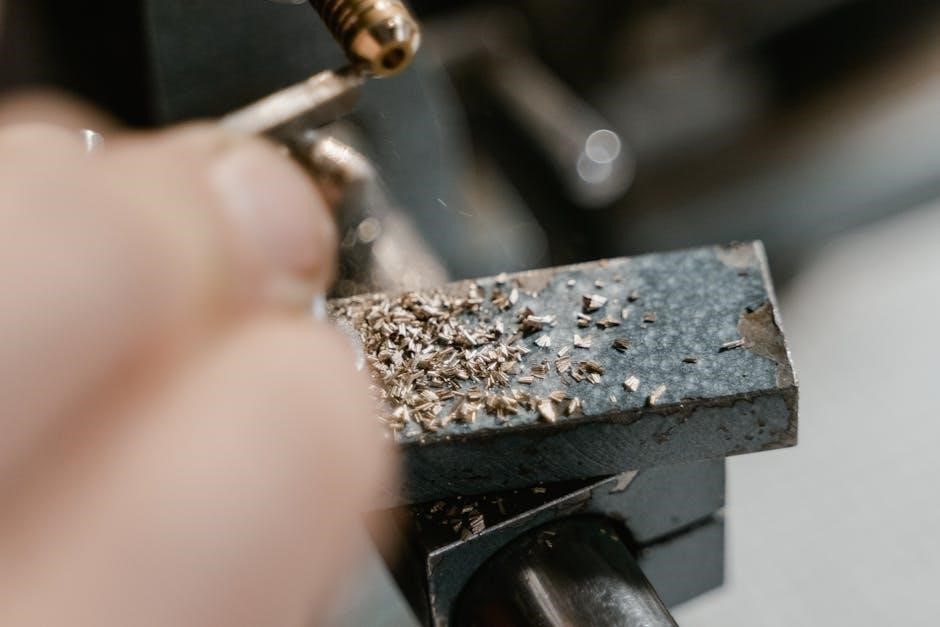
Future Trends in Manual Key Cutting
Future trends in manual key cutting emphasize portability, precision, and integration with modern technology. Battery-powered, portable machines are gaining popularity for their convenience and ease of use. Advanced models now feature smartphone app connectivity, enabling real-time calibration and key design customization. Compact, lightweight designs are becoming standard, reducing fatigue for locksmiths. Additionally, machines with interchangeable cutting wheels for various key types are expected to rise in demand. These innovations aim to enhance efficiency while maintaining affordability, making manual key cutting tools more accessible and user-friendly for professionals and hobbyists alike.
Manual key cutting tools remain indispensable for locksmiths and professionals, offering reliability and precision in key duplication. Their versatility, portability, and ease of use make them essential for various applications. With advancements in technology, these tools continue to evolve, ensuring accurate and efficient key production. Whether for automotive, residential, or commercial use, manual key cutters provide a cost-effective solution. By choosing the right machine and maintaining it properly, users can achieve professional-grade results. As locksmithing demands grow, manual key cutting tools will remain a cornerstone of the industry, balancing tradition with innovation to meet modern needs.

Frequently Asked Questions (FAQs)
Q: What types of keys can manual cutting machines duplicate?
A: They can duplicate flat, dimple, laser, and standard edge-cut keys for automotive, residential, and commercial use.
Q: How do I maintain my manual key cutter?
A: Regular cleaning, lubrication, and calibration are essential to ensure optimal performance and longevity.
Q: Are manual machines portable?
A: Yes, many models are lightweight and compact, making them easy to transport for on-site key duplication.
Q: What safety precautions should I take?
A: Wear safety goggles, gloves, and a dust mask to protect against metal shavings and debris.
Q: Can I use a manual cutter for specialized keys?
A: Some models support specialized keys, but check compatibility before purchasing.
Leave a Reply
You must be logged in to post a comment.